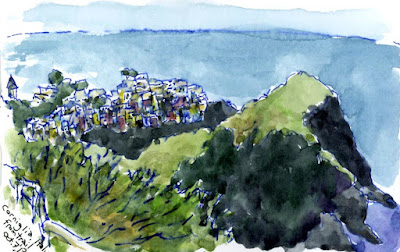On our third day in Cornwall, I took the Great Western Railway to the end of the line in Penzance, then a short bus ride to St. Michael's Mount - a castle on a tall rocky outcrop in the bay. It's an island at high tide, but at low tide you can walk out along a causeway. There's a little harbour (so you can get a boat ride back if the tide comes in), a small village and a fantastic castle above the steep forest. It is still inhabited by the local lord and family, but most of it is open to the public. It is covered in turrets, ramparts and other castley bits, but the inside is what really impressed me - timber-framed dining hall with stained glass windows, ornate sitting rooms, a cozy library with armchairs around the fire, places to store the blunderbusses, even a chapel. I think I'll put an offer in if it comes up for sale.

I sat in the sun on an upper deck (or whatever such a thing is called in a castle), against a wall to shelter from the blustery wind, and drew the top parts - chapel, armory, guard tower, all in full crenulation. Definitely not the sort of thing I get to draw back home.

Keeping an eye on the tide, I stopped in at the island's cafe for a "cream tea" - the traditional way in that part of the world to consume several thousand calories and not have it count as either lunch or dinner. There were two large creamy buttery scones, a bowl of clotted cream (basically a hybrid of butter and cream), a pot of jam, tea, and, of course, a jug of cream. It's the thing in Cornwall and neighbouring Devon. In Cornwall, one puts one's jam on the scone first, then the clotted cream. In Devon, one does the opposite. And so inter-regional scorn and contempt ensue. Being in Cornwall and a culturally-sensitive person, I went jam first. But I used a little artistic license in the drawing, because it looked better with the red on top.

To metabolize all that fat, I walked in the brisk wind through a nearby nature reserve before catching the double-decker back to Penzance. I walked around the old town, then, to balance my diet, stopped in at the Admiral Benbow for a pint. The old pub is where a distant relative set the first chapter of his Treasure Island, and it is full of paraphernalia, nautical and otherwise. It would drive a detail-oriented sketcher to drink (which is conveniently available).




























